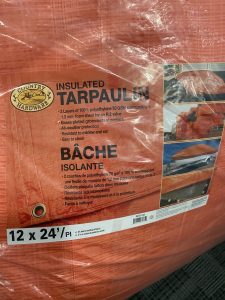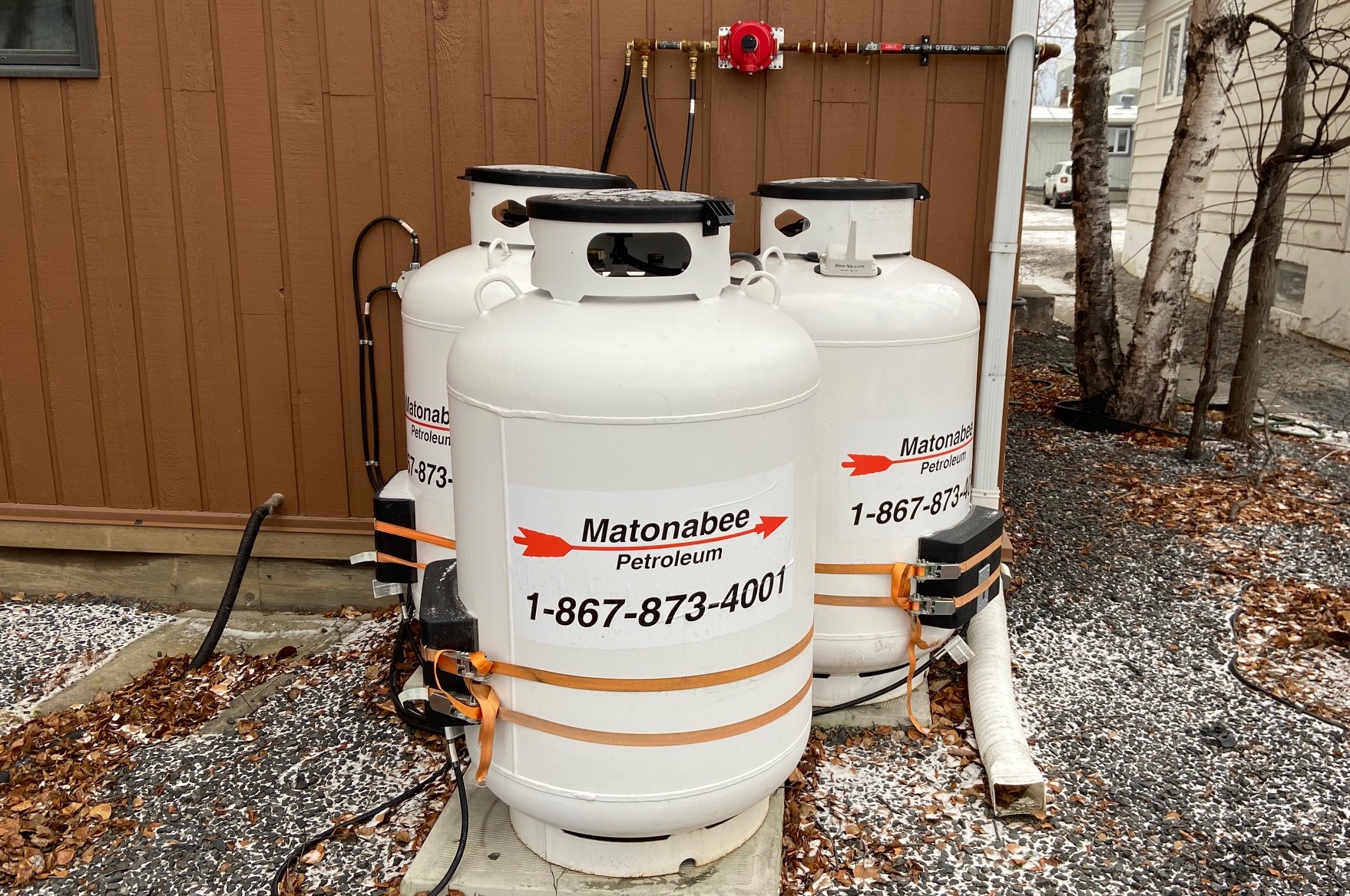December is a wonderful month in Yellowknife. Christmas lights are up, students are either home from university or soon will be, craft markets are going strong, both the NHL and NFL are in full swing …and the list goes on. But….and by that I mean BUT!!!!….it is getting colder outside, and soon those of us who heat our homes or businesses with propane will have to start playing the propane game.
There are many good reasons to heat your home with propane, but also one really big drawback. Below -42 degrees Celsius, propane is no longer a gas, it is a liquid, and it stubbornly refuses to exit your propane tank and flow through the fuel line to your furnace. It is not a question of “if” this will happen at -42. The debate is settled. It happens. So the only way to keep your furnace working is to prevent the propane in your tank from getting that cold. That’s the name of the game.
Or at least, it’s half the name of the game. When you lose at that first half, you have to play the second part of the game, which is to get your furnace working again in the middle of the night at ridiculously cold temperatures. This usually involves, at the very least, pouring boiling water over your propane regulator to get everything flowing again. And that’s almost never enough to fully do the job. I sometimes think it’s just recommended by professionals because it makes cool sounds, and vapour, and makes us feel like we’re not completely useless while waiting for the pros to show up.
Disclaimer time – I am a real estate broker, not a propane or furnace technician or chemical engineer, so the advice in this post should be run past a qualified professional before being implemented.
There are many other things that can be done, besides the boiling water trick, both to prevent a freeze-up and to recover from one, and this winter I have promised myself that I will try everything and write about the results. Why, you might ask? Well, two summers ago I converted our office to a propane boiler, and on at least four occasions last winter, I was awakened in the middle of the night by our security system monitoring agency, letting me know that the boiler had stopped working because the propane had “gelled”. Several dark, cold hours followed, with many promises made to myself of “never again.” This year, I am going to win the propane game, and I’m going to help everyone else win too, because it’s really not okay that we have to go through this.
But I may not win right away, because I’m not going to try everything all at once. If I were to do that, I wouldn’t be able to figure out which trick made the difference. What is required here is a scientific approach.
 Step one of the propane game is to have a plan. Last year, I thought I had a pretty good plan. First, I made sure I had three propane tanks, not just two. I don’t fully understand why this is so important (feedback in the comments would be appreciated if anyone knows), but I know that it has to do with keeping the total pressure in your tanks high enough to push gas through the fuel line. Two tanks empty out more quickly than three, and that creates problems. If your tanks are below 50% at -42, you are going to have issues.
Step one of the propane game is to have a plan. Last year, I thought I had a pretty good plan. First, I made sure I had three propane tanks, not just two. I don’t fully understand why this is so important (feedback in the comments would be appreciated if anyone knows), but I know that it has to do with keeping the total pressure in your tanks high enough to push gas through the fuel line. Two tanks empty out more quickly than three, and that creates problems. If your tanks are below 50% at -42, you are going to have issues.
Second, I had High-Q POLARPAD™ heaters installed, at not inconsiderable expense, on all three tanks. And I had them hardwired, as is required by the GNWT gas inspector (my understanding is that a regular plugin can be a source of sparks). I’m sure the folks at High-Q mean well, but despite what their website says, their heaters are not, in my opinion, “tough enough for the Arctic.” Four trips to my subarctic office in the middle of the night, and four emergency visits by the good people at J&R Mechanical, suggest otherwise.
Third, during cold snaps I made sure to check my propane levels every Thursday to ensure that, if levels were low, I could be included with the regular Friday or Saturday propane deliveries. If you’re not included in the regular deliveries, you may need to pay an extra fee for an emergency top-up. It is super important to speak with your propane supplier, develop a good relationship with them, and figure out their delivery schedule.
That was the extent of my year one plan, and it did not get the job done. So here are the changes I have made, or am about to make, for year two. First, I asked the experts at J&R Mechanical for advice. Always a good idea. They were pretty certain that the length of my fuel line and the location of my regulators was a problem. My plebian understanding of how regulators work is that they take the high-pressure propane from a tank and step it down, in two stages, to a pressure that can be used by a furnace or boiler. But this can be a problem if you step the pressure all the way down and then expect it to trickle through 30 feet of fuel line at -42 degrees Celsius. So what they did was to move the second regulator further from the tanks, closer to where the line goes into the building.

 Next, I purchased a remote temperature sensor, and I equipped it with lithium batteries (for cold weather). Two examples are pictured here. I don’t imagine it will do much to warm my propane tanks, but it will tell me if the other measures I’ve taken are working. Plus, it’s just kind of cool.
Next, I purchased a remote temperature sensor, and I equipped it with lithium batteries (for cold weather). Two examples are pictured here. I don’t imagine it will do much to warm my propane tanks, but it will tell me if the other measures I’ve taken are working. Plus, it’s just kind of cool.
And my final step for this year was to purchase an insulated tarp. There is no doubt in my untrained mind that heating a propane tank with a POLARPAD ™ at -42 or colder without also insulating the tank, is a waste of electricity and time.
 Another common means of insulating, or at least sheltering, propane tanks is to build a wooden “wind-block” around them, like the one pictured here. But from what I’ve seen, these work best when there is also heat source present. In this case, the slightly warmer air from a crawlspace.
Another common means of insulating, or at least sheltering, propane tanks is to build a wooden “wind-block” around them, like the one pictured here. But from what I’ve seen, these work best when there is also heat source present. In this case, the slightly warmer air from a crawlspace.
 I haven’t installed my new insulated tarp yet. On the one hand I want to wait to see if the change made to the regulator location will be enough to solve this problem. But on the other hand, I really don’t want to have to go to the office at -45 in the middle of the night. We’ll see how long I hold out. I’ll keep you posted.
I haven’t installed my new insulated tarp yet. On the one hand I want to wait to see if the change made to the regulator location will be enough to solve this problem. But on the other hand, I really don’t want to have to go to the office at -45 in the middle of the night. We’ll see how long I hold out. I’ll keep you posted.
EDIT: Two other things I did this year which I should mention, were to purchase a cold weather surface temperature reader, so that I can check the actual temperature of the tank, not just the air around it, and a Powerblanket, which I’m excited to try but will be holding in reserve until needed.

 Facebook
Facebook
 X
X
 Pinterest
Pinterest
 Copy Link
Copy Link

